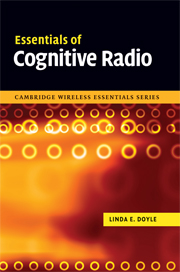Book contents
- Frontmatter
- Contents
- Acknowledgments
- List of abbreviations
- 1 A cognitive radio world
- 2 The essentials – an overview
- 3 Taking action
- 4 Observing the outside world
- 5 Making decisions
- 6 Security in cognitive radio
- 7 Cognitive radio platforms
- 8 Cognitive radio regulation and standardisation
- 9 Conclusions
- Appendix A Developments in the TV white spaces in the USA
- Index
4 - Observing the outside world
Published online by Cambridge University Press: 10 August 2009
- Frontmatter
- Contents
- Acknowledgments
- List of abbreviations
- 1 A cognitive radio world
- 2 The essentials – an overview
- 3 Taking action
- 4 Observing the outside world
- 5 Making decisions
- 6 Security in cognitive radio
- 7 Cognitive radio platforms
- 8 Cognitive radio regulation and standardisation
- 9 Conclusions
- Appendix A Developments in the TV white spaces in the USA
- Index
Summary
Introduction
To study observations, we return yet again to the definition of the cognitive radio laid out in Chapter 1 and note once more that ‘A cognitive radio is a device which has four broad inputs, namely, an understanding of the environment in which it operates, an understanding of the communication requirements of the user(s), an understanding of the regulatory policies which apply to it and an understanding of its own capabilities.’ Getting these four inputs is what we mean by the phrase ‘observing the outside world’.
We can further detail some of the observations that are needed if we go through the various action categories outlined in the last chapter. To take action from a frequency perspective the cognitive radio must observe which signals are currently being transmitted, which channels are free, the bandwidth of those channels and perhaps whether the available channels are likely to be short lived or more durable. To take action from a spatial perspective, the cognitive radio needs to make observations about the spatial distribution of systems that must be avoided, or the spatial distribution of interferers and of the target radios. The cognitive radio needs to be able to monitor its power output and the power output of other systems. To take action to make a signal more robust or to maximise the throughput of the transmitted signal, the cognitive radio needs to make observations about the signal-to-noise ratio (SNR) at the target receivers, about the bit error rates and about the propagation conditions experienced by the transmitted signal (e.g. delay spread, doppler spread).
- Type
- Chapter
- Information
- Essentials of Cognitive Radio , pp. 89 - 122Publisher: Cambridge University PressPrint publication year: 2009



